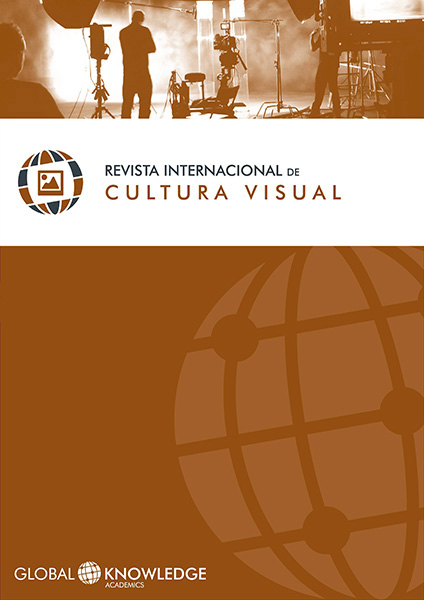The textual framework and the reiteration of the western sight tradition in “PICTURE WINDOWS” series
DOI:
https://doi.org/10.37467/gka-revvisual.v3.392Keywords:
Scopic Regime, Naturalism, Picture WindowsAbstract
The relevance of the representative tradition gets highlighted with a number of productions in the world of visual culture, demanding an analysis that question the own statute and condition of possibility of those images. The series of photographs by John Pfahl "PICTURE WINDOWS" proposes, from this analysis, an approach to the so-called scopic regime, referencing its inevitable link with visual memory constituted within the history of Western art. It is a possible way to revisit the narrative of Naturalism that has remained in a diversity of productive ways fell across by new types of images.
Downloads
References
Alberti, L. B. (2007). De la pintura y otros escritos sobre arte. (pp. 84-85). Madrid, España: Tecnos.
Arnheim, R. (1986). El pensamiento visual. (pp. 109-112). Barcelona, España: Paidós.
Aumont, J. (1992). La imagen. (p. 225). Barcelona, España: Paidós.
Barthes, R. (2009). Lo obvio y lo obtuso: imágenes, gestos y voces. (pp. 11-15). Barcelona, España: Paidós.
Beddington, C. (2010). Venice: Canaletto and his rivals. Londres, Reino Unido: The National Gallery.
Belting, H. (2007). Antropología de la imagen. (p. 265). Buenos Aires, Argentina: Katz Editores. DOI: https://doi.org/10.2307/j.ctvm7bcgx
Brea, J. L. (2007). Cambio de régimen escópico: del inconsciente óptico a la e-image. Revista Estudios Visuales, (4), 146-163.
Bright, D. (1992). The Machine in the Garden Revisited: American Environmentalism and Photographic aesthetics. Art Journal, 51(2), 60-71. DOI: https://doi.org/10.1080/00043249.1992.10791569
Cassirer, E. (2013). Filosofía de las formas simbólicas, II: El pensamiento mítico. México D. F., México: Fondo de Cultura Económica.
Crary, J. (2008). Las técnicas del observador. Visión y modernidad en el siglo XIX. Murcia, España: CENDEAC.
Eco, U. (1977). Tratado se semiótica general. (pp. 210-214). Barcelona, España: Lumen.
Eco, U. (2007). Perspectivas de una semiótica de las artes visuales. Criterios, (25-28), 221-233.
Foucault, M. (2008). Las palabras y las cosas. Una arqueología de las ciencias humanas. (pp. 37- 38). Buenos Aires, Argentina: Siglo XXI.
Francastel, P. (1960). Pintura y sociedad. (p. 64). Buenos Aires, Argentina: Emecé Editores.
Francastel, P. (1988). La realidad figurativa. I: El marco imaginario de la expresión figurativa. (p. 109). Barcelona, España: Paidós.
Galassi, P. (1981). Before Photography: painting and the Invention of Photography. Nueva York, Estados Unidos: The Museum of Modern Art.
Gombrich, E. H. (2000). Art and Ilusion: A study in the psychology of pictorial representation. (pp. 254-257).
Washington, D. C, Estados Unidos: Bollingen Series XXXV. Goodman, N. (1975). Los lenguajes del arte: una aproximación a la teoría de los símbolos. (pp. 28-30). Barcelona, España: Editorial Seix Barral.
Jay, M. (1988). Scopic Regimes of Modernity. Hal Foster. (Ed.), Vision and Visuality, (pp.3-23). Seattle, Estados Unidos: Bay Press.
Krauss, R. (2009). Los espacios discursivos de la fotografía. La originalidad de la Vanguardia y otros mitos modernos. (pp. 145-163). Madrid, España: Alianza.
Kubler, G. (1962). The Shape of Time. Remarks on the History of Things. New Haven, Estados Unidos: Yale University Press.
Metz, C. (1982). The imaginary signifier: psychoanalysis and the cinema. Bloomington, Estados Unidos: Indiana University Press.
Mitchell, W. J. T. (2009). Teoría de la imagen. (pp. 63-64). Madrid, España: Akal.
Panofsky, E. (1973). La perspectiva como forma simbólica. Barcelona, España: Marginales.
Pérez Carreño, F. (2002). Umberto Eco: del icono al texto estético. Valeriano Bozal. (Ed.). Historia de las ideas estéticas y de las teorías artísticas contemporáneas Volumen II. (pp. 86-91). Madrid, España: La balsa de la Medusa.
Romero, J. L. (2011). La Edad Media. Buenos Aires, Argentina: Fondo de Cultura Económica.
Sontag, S. (2006). Sobre la fotografía. (p. 231). México D. F:, México: Alfaguara.
Soulages, F. (2010). Estética de la fotografía, Buenos Aires, Argentina: La Marca Editora.
Stafford, B. M. y Terpak, F. (2001). Devices of Wonder. From the world in a box to images on a screen. Los Angeles, Estados Unidos: The Getty Reasearch Institute.
Stoichita, V. (2000). La invención del cuadro. Arte, artífices y artificios en los orígenes de la pintura europea. Barcelona, España: Ediciones del Serbal.
Tatarkiewicz, W. (2010). Historia de seis ideas: Arte, belleza, forma, creatividad, mimesis, experiencia estética. (pp. 325-327). Madrid, España: Tecnos/Alianza.
Downloads
Published
How to Cite
Issue
Section
License
Those authors who publish in this journal accept the following terms:
- Authors will keep the moral right of the work and they will transfer the commercial rights.









